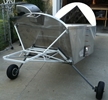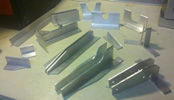


random user submitted photo
Aerovee Overhaul Guide?
11 posts
• Page 2 of 2 • 1, 2
Re: Aerovee Overhaul Guide?
lutorm wrote:I used the Wilson book when rebuilding our Aerovee but if it's new and you don't need to check tolerances it might not be that useful.
I found the book useful for both disassembly and assembly. There are little things in the AeroVee manual that are not mentioned or are not entirely clear, and there are numerous photos in the book that also helped, so the book helped fill in the gaps and add to my understanding.
The most difficult part of the assembly, to me, was getting the end play correct. When setting your shims the flywheel goes on dry (without RTV sealant), but when you do the final assembly you need to take into account the added thickness of the sealant. So I set my shims to get the minimum movement of .003. After installing with the sealant I got around .004+.
http://www.mykitlog.com/users/display_l ... 775&row=32
It took me nearly 2 months to build my AeroVee the first time. I had never built an engine, so was both nervous and careful the first time. When I replaced my Nickasil cylinders with cast iron, it took me 3 weeks to disassemble and reassemble the engine (I replaced all the bearings due to metals in the engine/oil). When I had a prop strike and had to replace the crank and bearings, it took me 2 nights to disassemble, and 2 nights to reassemble the engine. It's pretty easy once you know what you're doing, but it took 3 times to feel that confident.
If you do disassemble and assemble the engine, do a CC check on the heads. You will likely find differences that can be evened out with cylinder base shims and/or different thicknesses of head gaskets.
http://www.mykitlog.com/users/display_l ... 205&row=44
http://www.mykitlog.com/users/display_l ... 690&row=34
http://www.csgnetwork.com/compcalc.html
https://www.youtube.com/watch?v=L5mwBHW0NJE
https://www.youtube.com/watch?v=df_fwtCisMo
Mike Smith
Sonex N439M
Scratch built, AeroVee, Dual stick, Tail dragger
http://www.mykitlog.com/mikesmith
Sonex N439M
Scratch built, AeroVee, Dual stick, Tail dragger
http://www.mykitlog.com/mikesmith
- mike.smith
- Posts: 1430
- Joined: Tue Jan 29, 2013 8:45 pm
11 posts
• Page 2 of 2 • 1, 2
Who is online
Users browsing this forum: autopro and 75 guests







